The modern business world is dynamic and competitive, demanding constant innovation and adaptation. Generative AI for business has emerged as a groundbreaking technology, offering robust AI-driven business solutions to tackle complex challenges and unlock unprecedented growth.
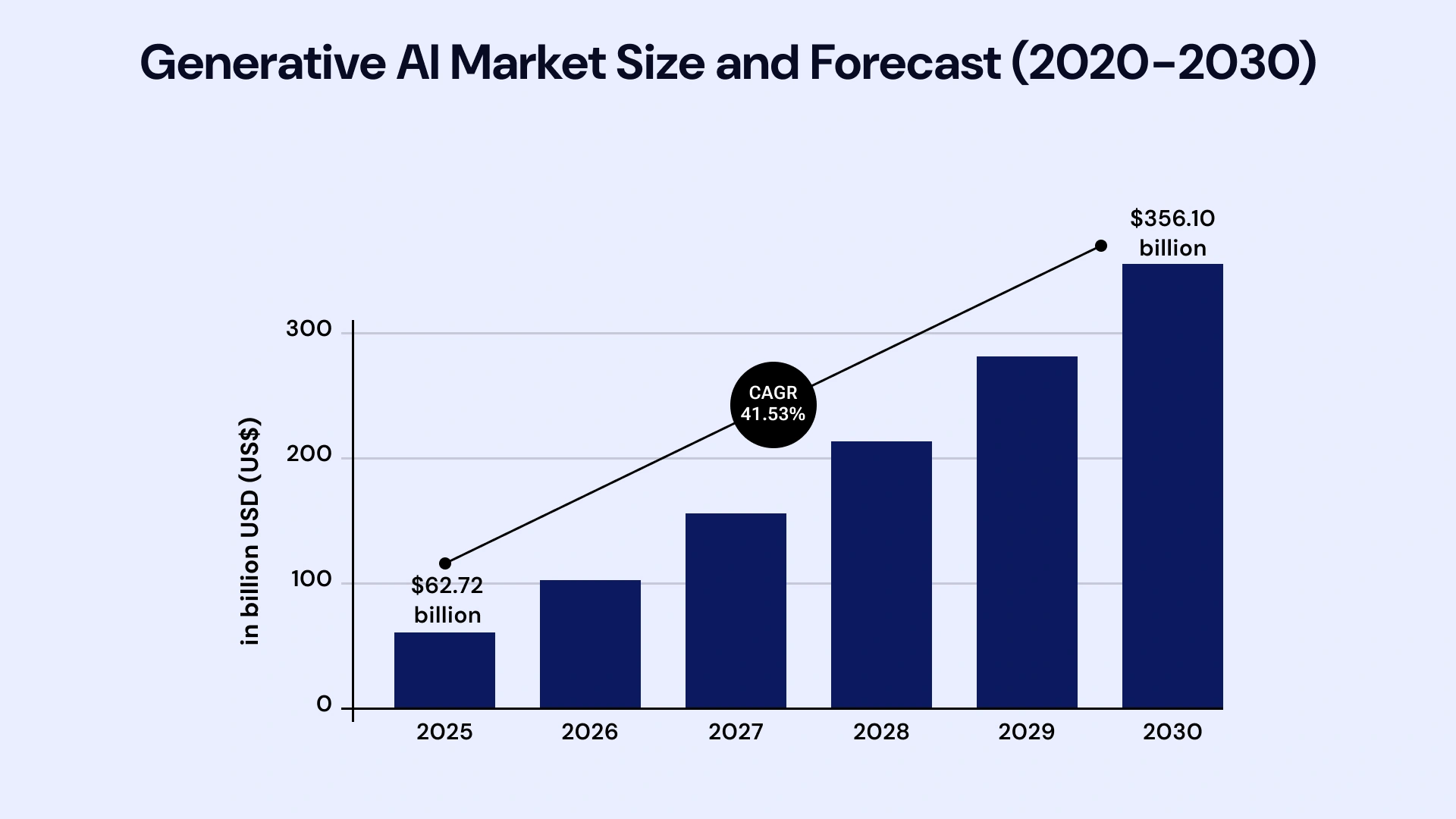
This exponential growth underscores the transformative potential of Generative AI for business and its ability to revolutionize industries. This blog will delve into how AI-powered problem-solving is reshaping the business landscape and empowering organizations to thrive.
What Is Generative AI and What Can It Do?
Generative AI is a class of sophisticated artificial intelligence algorithms designed to create entirely new, original content. Unlike traditional AI, which focuses on analyzing existing data, Generative AI learns the intricate patterns and structures of input data and then generates similar yet unique data.
This can encompass a broad spectrum of outputs, including text, images, audio, video, code, 3D models, and even entirely new chemical compounds. Enterprise AI solutions are increasingly incorporating this technology to drive innovation and efficiency.
The capabilities of Generative AI-powered problem-solving are vast and continually expanding. Here are some key functionalities:
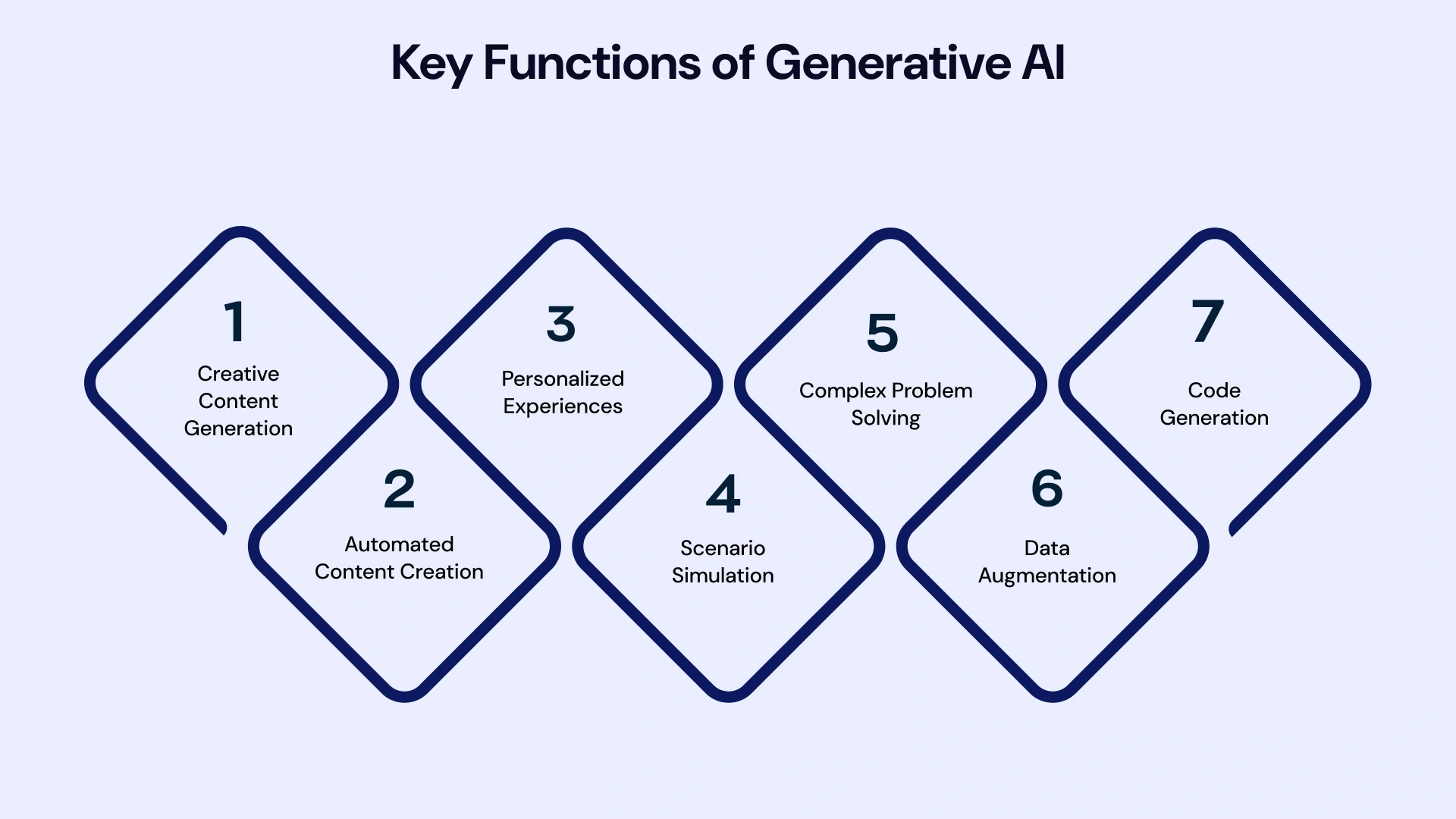
Creative Content Generation:
Generative AI can unleash creative potential by generating marketing copy, composing music, designing product prototypes, creating art, and even writing different kinds of creative content, including poems, code, scripts, musical pieces, emails, letters, etc. It empowers businesses to explore new creative avenues and develop unique offerings.
Automated Content Creation:
AI automation can automate repetitive and time-consuming tasks for businesses, such as generating product descriptions, summarizing lengthy documents, translating languages, or creating personalized emails. This AI-driven business solution frees up valuable human resources for more strategic and high-value work.
Personalized Experiences:
Generative AI can personalize content, recommendations, and interactions to cater to individual users, significantly enhancing customer engagement and fostering brand loyalty. Today, the implementation of AI solutions strengthens AI-powered customer engagement and drives customer satisfaction.
Scenario Simulation:
By generating realistic simulations, Generative AI enables businesses to test new strategies, predict outcomes, and optimize processes in a safe and controlled environment. This AI-driven business solution provides valuable business intelligence with AI and improves decision-making.
Complex Problem Solving:
Generative AI can model intricate systems, identify hidden patterns, and generate innovative solutions to complex business problems that would be difficult or impossible for humans to solve alone. This fosters AI-powered data-driven decision-making and drives innovation.
Data Augmentation:
In situations where training data is limited, Generative AI can create synthetic data to augment the existing dataset. AI-driven business solutions can also improve the performance and robustness of machine learning in business models.
Code Generation:
Generative AI can even generate code in various programming languages, accelerating software development and improving developer productivity.
Types of Generative AI Models: A Deep Dive
Generative AI's remarkable capabilities are powered by a diverse range of models, each with its strengths and suited to different applications. Understanding these models is key to choosing the right approach for your business needs.
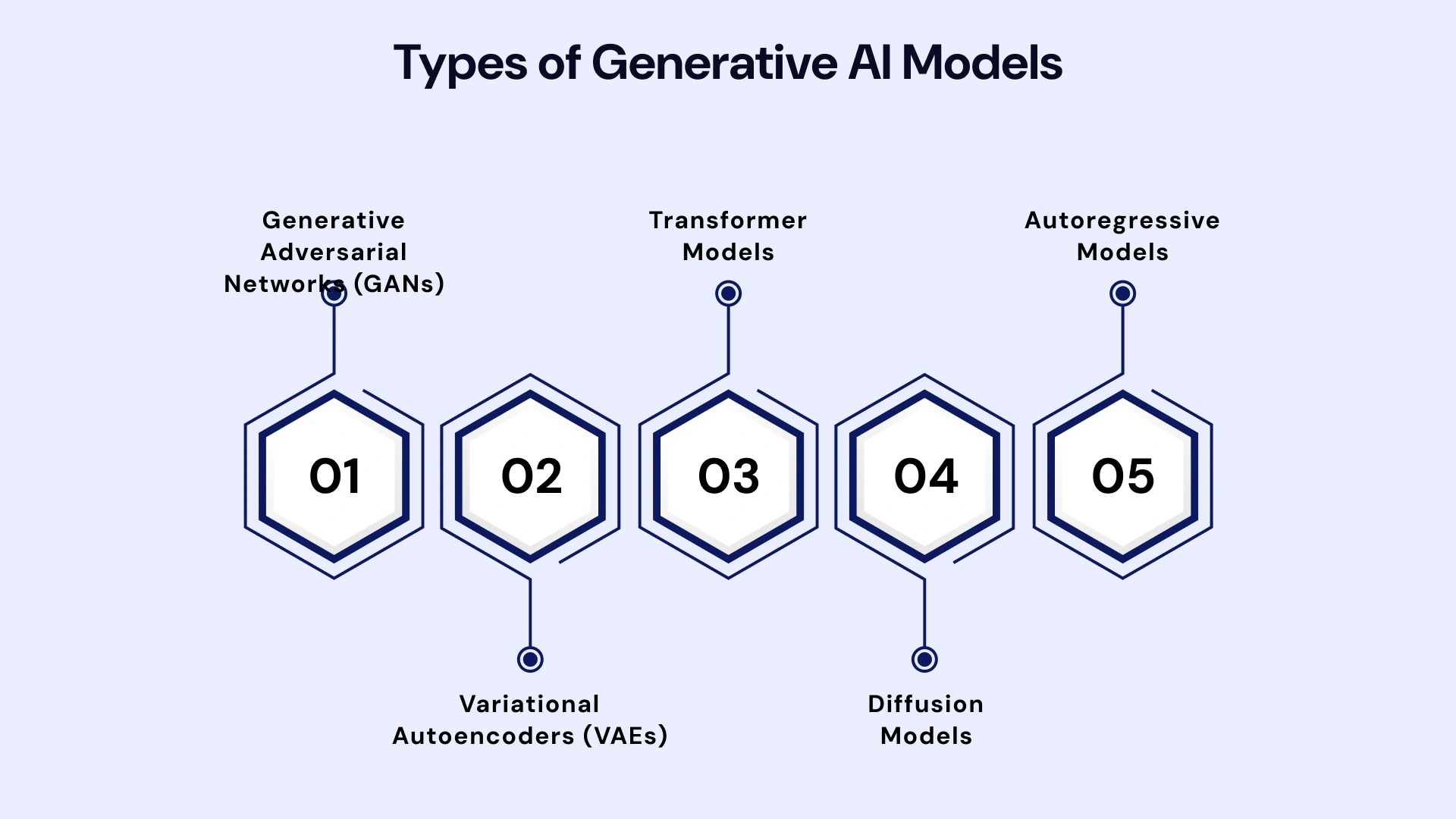
1. Generative Adversarial Networks (GANs): The Art of Adversarial Learning
GANs are a fascinating class of models that employ two neural networks—a generator and a discriminator—in a competitive, adversarial dance. This AI for business growth generator creates new data that mimics the actual data distribution, while the discriminator distinguishes between real data and the data generated by the generator.
How it Works: The generator and discriminator are trained simultaneously. As the generator improves at creating realistic data, the discriminator also improves at spotting fakes. These constant back-and-forth pushes both networks to improve, ultimately leading to the generator producing highly realistic and complex data.
Strengths: GANs excel at generating high-resolution images, videos, and even 3D models. They are also used for image editing, style transfer, and super-resolution for AI-powered customer engagement.
Weaknesses: GANs can be challenging to train, requiring careful tuning of hyperparameters. They are also prone to mode collapse, where the generator gets stuck and produces limited variations of the same output.
Examples: Creating photorealistic images of people who don't exist, generating high-definition textures for video games, and enhancing the resolution of images.
2. Variational Autoencoders (VAEs): Learning Latent Representations
VAEs take a different approach. They learn a compressed, latent representation of the input data. This AI for business growth latent space captures the essential features of the data, allowing the VAE to generate new data by sampling from it.
How it Works: VAEs consist of an encoder and a decoder. The encoder maps the input data to a latent space, while the decoder maps points in the latent space back to data space. By learning probabilistic mapping, VAEs can generate diverse and varied outputs.
Strengths: VAEs are effective for generating data with specific characteristics, such as generating images of faces with particular attributes (e.g., eye color, hair color). They are also helpful for anomaly detection and data denoising.
Weaknesses: VAEs tend to produce slightly blurrier or less sharp images compared to GANs.
Examples: Generating variations of existing images, creating new music compositions with specific styles, and detecting anomalies in manufacturing data.
3. Transformer Models: The Power of Attention
Transformer models, particularly large language models (LLMs), have revolutionized Natural Language Processing (NLP). Their ability to process and understand long sequences of text has led to breakthroughs in tasks such as text generation, translation, summarization, and question-answering.
How it Works: Transformers utilize the "attention mechanism," which allows the model to focus on different parts of the input sequence when processing it. This enables them to capture long-range dependencies and more effectively understand the context of the text.
Strengths: Transformers excel at generating coherent and contextually relevant text. They are also very effective for tasks involving sequence-to-sequence learning, such as translation.
Weaknesses: Training large transformer models requires significant computational resources and large datasets.
Examples: Writing articles, translating languages, creating chatbots, summarizing long documents, and generating creative content like poems or code.
4. Diffusion Models: The Art of Reversal
Diffusion models work by gradually adding noise to the input data until it becomes pure noise. Then, they learn to reverse this process to generate new data. This AI-driven business solution, a seemingly counterintuitive approach to AI for business growth, has yielded remarkable results, especially in image generation.
How it Works: The forward process gradually diffuses the data, while the reverse process learns to remove the noise step-by-step, generating a new data sample.
Strengths: Diffusion models have achieved state-of-the-art results in image generation, often producing highly realistic and detailed images. They are also less prone to mode collapse compared to GANs.
Weaknesses: Diffusion models can be computationally expensive to train and sample from.
Examples: Generating high-quality images from text descriptions, creating realistic edits to existing images, and generating 3D models.
5. Autoregressive Models: Predicting the Next Step
Autoregressive models generate data by predicting the next element in a sequence, given the previous aspects. They are handy for generating sequential data, like text or music.
How it Works: These models learn the probability distribution of each element in the sequence, conditioned on the previous elements. They then generate new sequences by sampling from this distribution.
Strengths: Autoregressive models are good at capturing long-range dependencies in sequential data.
Weaknesses: They can be computationally expensive for long sequences, as the model needs to process the entire sequence up to the current element to generate the next one.
Examples: Generating text, composing music, predicting time series data.
Choosing the Right Model:
The best Generative AI model for your business will depend on your specific needs and the type of data you're working with. Consider factors like the type of content you want to generate, the level of realism required, the computational resources available, and the complexity of the task. Consulting with AI experts can help you make the right decision.
What 10 Challenges Do Generative AI Solutions Solve for Businesses?
Generative AI is rapidly becoming indispensable for businesses striving to overcome a range of persistent challenges. Its unique ability to create novel content, analyze complex data at scale, and automate intricate processes offers solutions to problems that have traditionally hindered growth and efficiency.
Here are ten key challenges that Generative AI effectively solves, along with the transformative impact it brings:
1. Content Creation Bottlenecks: From Stagnation to Streamlined Storytelling
- Challenge: Producing high-quality, engaging content consistently is a significant bottleneck. Teams struggle to keep up with demand, impacting marketing campaigns and brand visibility.
- Generative AI Solution: Automates the creation of diverse content formats with free ChatGPT, from marketing copy and product descriptions to blog posts, social media updates, and even video scripts.
- Impact: Frees up human resources to focus on strategy and creative direction. Significantly increases content output, reduces time-to-market, and allows for more personalized and targeted messaging. Imagine a marketing team that can now A/B test dozens of ad variations in the time it used to take to create just one.
2. Lack of Personalization: From Generic to Tailored Experiences
Challenge: Generic marketing and customer interactions fail to resonate with individual users, leading to low engagement and conversion rates.
Generative AI Solution: This AI-powered decision-making enables businesses to tailor content, recommendations, and interactions to individual user preferences, analyze past behavior, and generate personalized offers.
Impact: Increases engagement, higher conversion rates, stronger customer loyalty, and improved customer lifetime value. Think of e-commerce platforms that can now generate unique product recommendations for each user, dramatically increasing sales.
3. Slow and Inefficient Processes: From Manual Labor to Automated Excellence
Challenge: Many business processes are still manual, time-consuming, and prone to errors. This impacts productivity and increases operational costs.
Generative AI Solution: Automates repetitive tasks, streamlines workflows, and improves overall efficiency. This includes automating data entry, generating reports, optimizing supply chain logistics, and even automating parts of the software development lifecycle.
Impact: Reduces operational costs, improves productivity, and frees up employees to focus on more strategic and creative work. Imagine a finance department that can now automate report generation, freeing up analysts to focus on higher-value tasks.
4. Difficulty in Data Analysis: From Data Overload to Actionable Insights
Challenge: Businesses are often overwhelmed by the sheer volume of data they collect. Analyzing this data to extract meaningful insights is a complex and time-consuming process.
Generative AI Solution: Analyzes complex and massive datasets, identifies hidden patterns and extracts valuable insights that would be difficult or impossible to obtain manually. Generative AI can even create synthetic data to augment existing datasets and improve model training.
Impact: It enables data-driven AI-powered decision-making, provides a significant competitive advantage, and uncovers new business opportunities. Imagine a retail company that can now predict customer demand with greater accuracy, optimize inventory, and reduce waste.
5. Limited Innovation: From Incremental Improvements to Breakthrough Discoveries
Challenge: Generating genuinely innovative ideas and developing new products and services can be challenging. Traditional brainstorming and development processes can be slow and inefficient.
Generative AI Solution: Business intelligence with AI solutions assists in brainstorming, generates new designs, and even simulates the performance of new products. It fosters creativity and accelerates the pace of AI-driven innovation. It can even help discover new materials or chemical compounds.
Impact: Generative AI leads to the development of more innovative products and services, faster time to market, and increased competitiveness. Imagine a pharmaceutical company using it to design new drugs more quickly and effectively.
6. High Costs of Manual Tasks: From Expense to Efficiency
Challenge: Manual tasks are not only time-consuming but also expensive. Labor costs, errors, and inefficiencies can significantly impact profitability.
Generative AI Solution: This AI for business growth reduces manual labor and associated costs, leading to significant cost savings and improved profitability. It can automate customer support interactions or streamline back-office operations.
Impact: Reduces operational expenses, improves profit margins, and frees up capital for reinvestment in the business.
7. Difficulty in Predicting Market Trends: From Guesswork to Data-Driven Forecasting
Challenge: Predicting future market trends is crucial for business planning, but it can be challenging. Traditional market research methods can be slow and inaccurate.
Generative AI Solution: This solution analyzes market data, identifies emerging trends, and forecasts future demand, enabling businesses to make informed decisions and stay ahead of the competition.
Impact: Improves business planning, reduces risk, and allows businesses to capitalize on emerging opportunities.
8. Challenges in Customer Service: From Frustration to Delight
Challenge: Providing excellent customer service can be demanding, especially for businesses with a large customer base. Long wait times, inconsistent service, and lack of personalization can lead to customer frustration.
Generative AI Solution: Improves customer service by providing 24/7 support, answering common queries, and personalizing interactions through AI-powered chatbots and virtual assistants.
Impact: Enhance customer experience with AI, improve customer retention, and reduce customer service costs.
9. Lack of Scalability: From Bottlenecks to Seamless Growth
Challenge: As businesses grow, scaling operations can be a significant challenge. Hiring and training new employees, expanding infrastructure, and managing increasing complexity can put a strain on resources.
Generative AI Solution: Business intelligence with AI solutions easily scales to meet the evolving needs of growing businesses, ensuring that they can continue to operate efficiently and effectively even as they expand.
Impact: Enables businesses to scale rapidly without sacrificing efficiency or quality of service.
10. Difficulty in Creating Realistic Simulations: From Complexity to Clarity
Challenge: Creating realistic simulations for training, planning, and testing can be complex and expensive. Traditional simulation methods often require specialized software and expertise.
Generative AI Solution: Generates highly realistic simulations, enabling businesses to test new strategies, train employees, and optimize processes in a safe and cost-effective environment.
Impact: Generative AI reduces risk, improves training outcomes, and allows for more effective planning and business process optimization. Imagine a manufacturing company using it to simulate different production scenarios before implementing changes on the factory floor.
By addressing these ten key challenges, Generative AI empowers businesses not only to solve immediate problems but also to fundamentally transform their operations, unlock new levels of innovation, and achieve sustainable growth in an increasingly competitive world. The impact of Generative AI extends beyond mere efficiency gains; it's about reimagining what's possible and creating entirely new opportunities for value creation.
How Can Businesses Successfully Adopt Generative AI Solutions?
Successfully integrating custom enterprise AI solutions requires careful planning and execution. Here's a comprehensive guide to help businesses adopt Generative AI effectively:
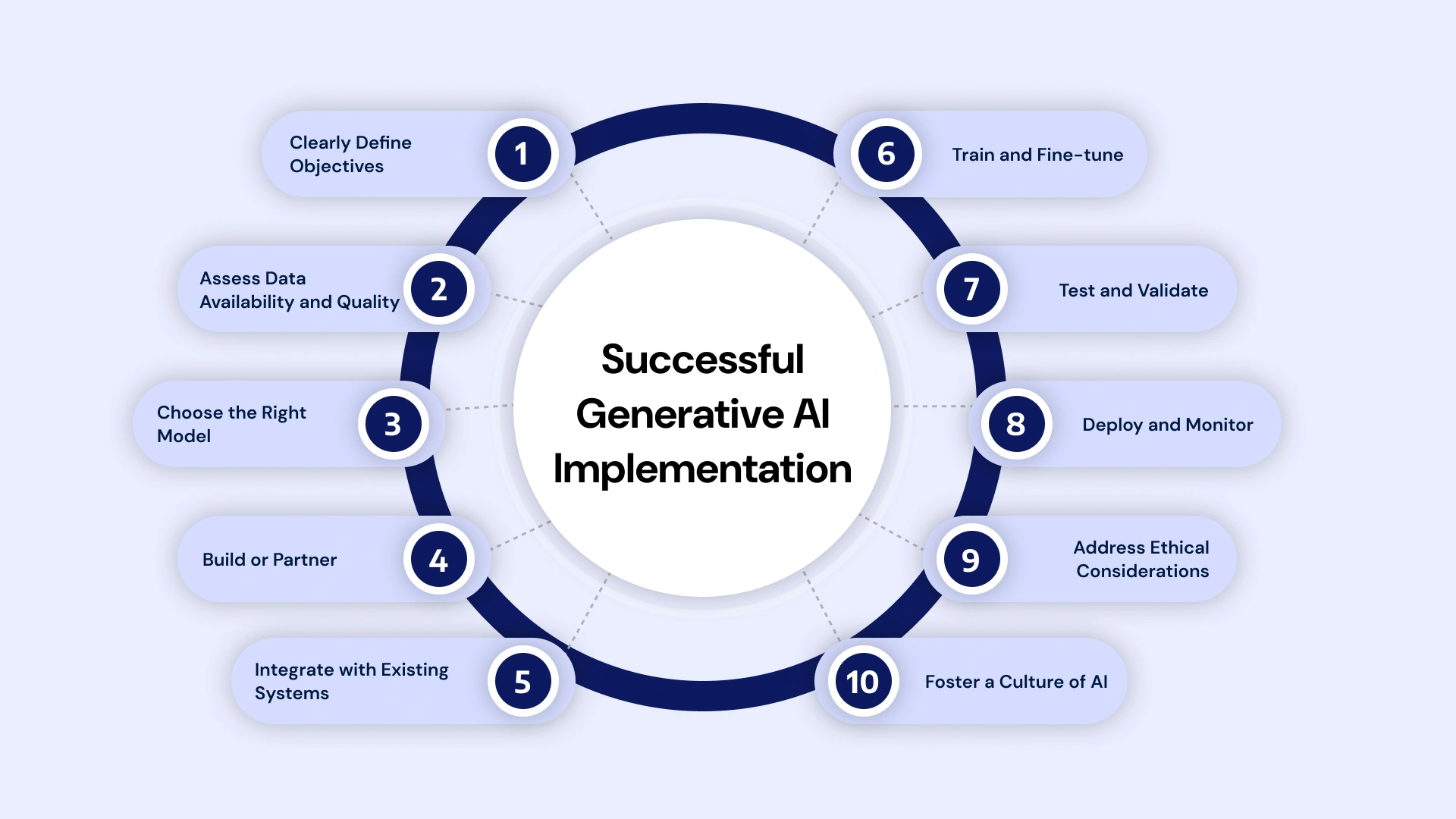
Clearly Define Objectives: Before embarking on any AI project, clearly define the specific business challenges you want to address and the desired outcomes. What problems are you trying to solve, and how will you measure success?
Assess Data Availability and Quality: Generative AI models require large amounts of high-quality data for training. Assess the availability and quality of your data. Is it clean, relevant, and representative of the problem you're trying to solve? If not, you'll need to invest in data collection and cleaning.
Choose the Right Model: Based on your specific application and the type of data you're using, select the most appropriate generative AI model. Different models are suited for custom enterprise AI solutions that have other tasks. Do your research and consult with AI experts if necessary.
Build or Partner: Decide whether to build your own Generative AI solution or partner with a company that offers pre-trained models or custom solutions. Building in-house requires significant expertise while partnering can be faster and more cost-effective.
Integrate with Existing Systems: Seamlessly integrate the Generative AI solution into your existing business workflows, systems, and infrastructure. This may require some technical expertise and careful planning.
Train and Fine-tune: Train the model on your prepared data and fine-tune it to achieve optimal performance. This is an iterative process that may require several rounds of training and evaluation.
Test and Validate: Thoroughly test and validate the model's performance before deploying it to a production environment. Ensure that it meets your requirements and performs reliably.
Deploy and Monitor: Deploy the trained model into a production environment and continuously monitor its performance to ensure accuracy, reliability, and effectiveness. Be prepared to retrain the model as needed in your enterprise AI solutions.
Address Ethical Considerations: Consider the potential ethical implications of using Generative AI, such as bias in the data, misuse of generated content, and possible job displacement. Implement safeguards and ensure responsible AI development.
Foster a Culture of AI: Create an organizational culture that embraces AI and encourages experimentation. Provide training and support to help employees understand and use Generative AI tools effectively.
Industries Leveraging Generative AI for Innovation
Generative AI is rapidly transforming a wide range of industries, driving innovation and creating new opportunities:
Marketing and Advertising:
Generative AI is revolutionizing marketing and advertising by enabling personalized ads, generating compelling marketing copy, designing product visuals, and creating targeted campaigns. Leverage AI for smarter decisions can also be used to create virtual influencers and personalized customer journeys.
Entertainment and Media:
In the entertainment industry, Generative AI is used to create realistic special effects, generate virtual characters, compose music, develop immersive gaming experiences, and even write movie scripts.
Healthcare and Pharmaceuticals:
Generative AI in healthcare is accelerating drug discovery, analyzing medical images to detect diseases, personalizing treatment plans, and developing new therapies. It can also generate synthetic data for medical research.
Manufacturing and Engineering:
Generative AI is used to design new products, optimize production processes, predict equipment failures, improve quality control, and even generate new materials with desired properties.
Finance and Banking:
In the financial sector, Generative AI in fintech is used to make smarter decisions, detect fraud, predict market trends, personalize financial advice, automate trading strategies, and manage risk.
Retail and E-commerce:
Generative AI is transforming retail by personalizing product recommendations, generating virtual try-on experiences, optimizing inventory management, and creating personalized shopping experiences.
Education and Training:
Generative AI in education is being used to create personalized learning experiences, generate educational content, provide automated feedback to students, and develop interactive training simulations.
Gaming and Virtual Reality:
Generative AI enhances gaming experiences by creating realistic game worlds, generating AI characters, and developing personalized game narratives. It is also playing a key role in the development of virtual reality and metaverse experiences.
Art and Design:
Generative AI is empowering artists and designers to explore new creative possibilities by generating unique art, designing new products, and creating personalized visual content.
Software Development:
Generative AI is being used to generate code in various programming languages, automate software testing, and even help developers find and fix bugs in their code during custom AI software development.
10 Real-World Examples of Generative AI
Generative AI is rapidly transforming various industries. Here are 10 real-world examples of its applications:
Google's Bard/Search: Google extensively uses Generative AI in its search engine and AI chatbot Bard to provide more relevant and comprehensive search results, generate creative content, and answer user queries conversationally.
Salesforce Einstein: Salesforce uses Generative AI to automate sales tasks, personalize customer interactions, generate marketing content, and provide AI-powered insights to sales teams.
General Motors: GM employs Generative AI to design new car models, simulate crash tests, optimize manufacturing processes, and develop autonomous driving technologies.
Goldman Sachs: Goldman Sachs utilizes Generative AI for financial modeling, risk management, personalized investment advice, fraud detection, and algorithmic trading.
Jasper.ai: A popular tool for generating marketing copy, blog posts, website content, and other written materials, empowering marketers and content creators to produce high-quality content quickly and efficiently.
DALL-E 2 (OpenAI): Creates realistic and creative images from natural language descriptions, allowing users to visualize their ideas and concepts and generate unique visual content.
Runway ML: A platform that provides tools for creating and experimenting with Generative AI models for video, images, and other media, enabling artists and creators to explore new creative possibilities and develop innovative visual content.
GitHub Copilot: Developed in collaboration between GitHub and OpenAI, Copilot uses Generative AI to provide code suggestions and even generate entire functions within integrated development environments (IDEs), boosting developer productivity.
Synthesia: Synthesia uses Generative AI to create AI avatars that can deliver video presentations in multiple languages, making it easier
Midjourney: Midjourney is an AI art generator that creates images from textual descriptions, similar to DALL-E 2. It's accessible through Discord and is known for its artistic and stylized outputs, often used by artists and designers for inspiration and content creation.
These examples demonstrate the diverse applications of Generative AI across various industries and highlight its potential to boost business efficiency with AI. As technology continues to evolve, we can expect to see even more innovative and transformative applications emerge in the near future.
Future Trends in Gen AI for Businesses
The future of AI is filled with exciting possibilities, with several key trends shaping its trajectory:
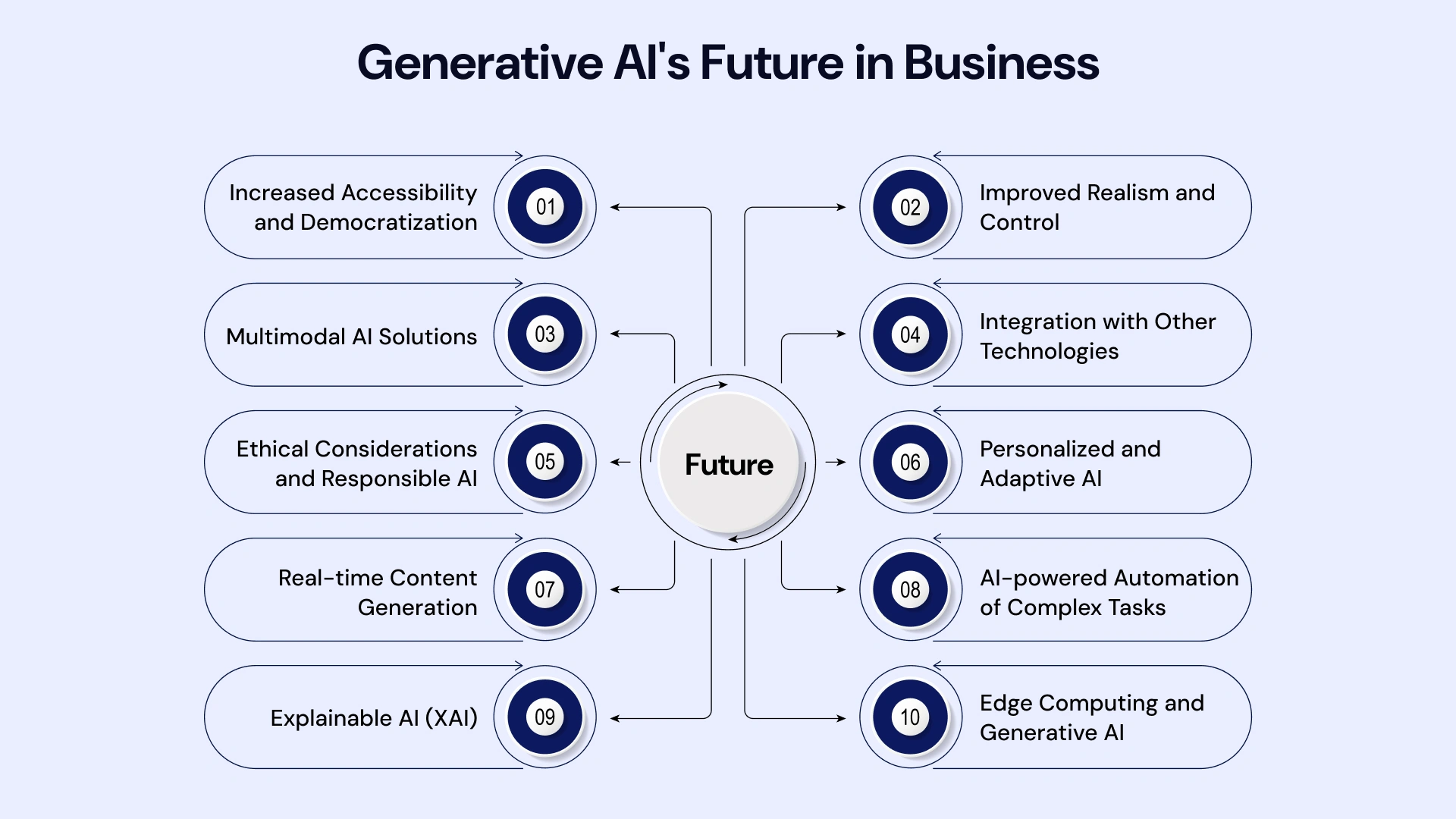
Increased Accessibility and Democratization:
Generative AI tools are becoming increasingly accessible and user-friendly. They are lowering the barrier to entry for businesses of all sizes and empowering individuals to explore their potential. Generative AI automation for enterprises will no longer be solely the domain of large corporations with vast resources.
Improved Realism and Control:
Generative AI models will continue to improve in accuracy, realism, and controllability, generating even more compelling and valuable content. Users will have greater control over the generated output, allowing for fine-tuning and customization.
Multimodal AI Solutions:
Models that can generate and understand multiple types of data, such as text, images, audio, video, and even sensor data, will become more prevalent. This AI in business transformation will enable more comprehensive and integrated AI solutions.
Integration with Other Technologies:
Generative AI will be increasingly integrated with other cutting-edge technologies, such as cloud computing, Internet of Things (IoT), blockchain, and augmented reality (AR), to create even more powerful and transformative solutions.
Ethical Considerations and Responsible AI:
There will be a growing emphasis on addressing the ethical implications of Generative AI and ensuring its responsible and unbiased use. This includes mitigating risks related to data bias, misuse of generated content, and potential job displacement. Transparency and accountability will be crucial.
Personalized and Adaptive AI:
Generative AI will become more personalized and adaptive, learning from user interactions and tailoring its output to individual preferences and needs. This will lead to more engaging and relevant experiences.
Real-time Content Generation:
Generative AI will move towards real-time content generation, enabling dynamic and interactive experiences. Transforming your business with AI will have significant implications for areas like gaming, virtual reality, and live events.
AI-powered Automation of Complex Tasks:
Generative AI will automate increasingly complex tasks, freeing up human resources for more strategic and creative endeavors. AI workflow automation will drive further efficiency gains and innovation.
Explainable AI (XAI):
As Generative AI becomes more sophisticated, there will be a growing need for Explainable AI. This type of AI integration in digital transformation focuses on making the decision-making processes of AI models more transparent and understandable. This will build trust and facilitate better collaboration between humans and AI.
Edge Computing and Generative AI:
Combining Generative AI with edge computing will enable real-time content generation and processing on devices, reducing latency and improving performance. This will be crucial for applications like autonomous vehicles and robotics.
Leverage VLink’s Gen AI Expertise for Your Business Success
In today's rapidly evolving technological landscape, Generative AI has emerged as a game-changer, offering businesses unprecedented opportunities for innovation, efficiency, and growth. Harnessing its full potential, however, requires specialized expertise. This is where VLink excels.
VLink’s AI development services empower businesses to harness the transformative power of Generative AI. Our expert team crafts tailored solutions using cutting-edge models like GANs, VAEs, Transformers, and Diffusion to address your unique challenges and objectives. We specialize in diverse applications, from content creation and data augmentation to process optimization and personalized experiences.
Our collaborative approach ensures seamless integration with your existing systems. We assess your data, select the optimal model, and provide ongoing support to maximize the value and adaptability of your Gen AI solution. Partnering with VLink unlocks faster time to market, reduced costs, increased innovation, and a significant competitive advantage.
Conclusion
Generative AI is rapidly transforming the business landscape, offering robust AI-driven efficiency solutions for AI-powered problem-solving, driving AI for business growth, and facilitating AI in business transformation. By understanding its capabilities, businesses can leverage smart AI applications for smarter decisions, accelerate growth with AI-driven insights, optimize workflows with AI automation, and significantly enhance customer experience with AI.
It's time to implement AI solutions today and boost business efficiency with AI. The potential of Generative AI for business is vast and constantly expanding. Businesses that embrace this transformative technology and strategically integrate it into their operations will be well-positioned for success in the dynamic and competitive world of tomorrow.
Ready to transform your business with AI? Contact VLink today to discuss your Gen AI needs and discover how we can help you achieve your business goals. Our team is ready to guide you through the process, from initial consultation to deployment and ongoing support. Let us help you unlock the transformative power of Generative AI and drive your business success.
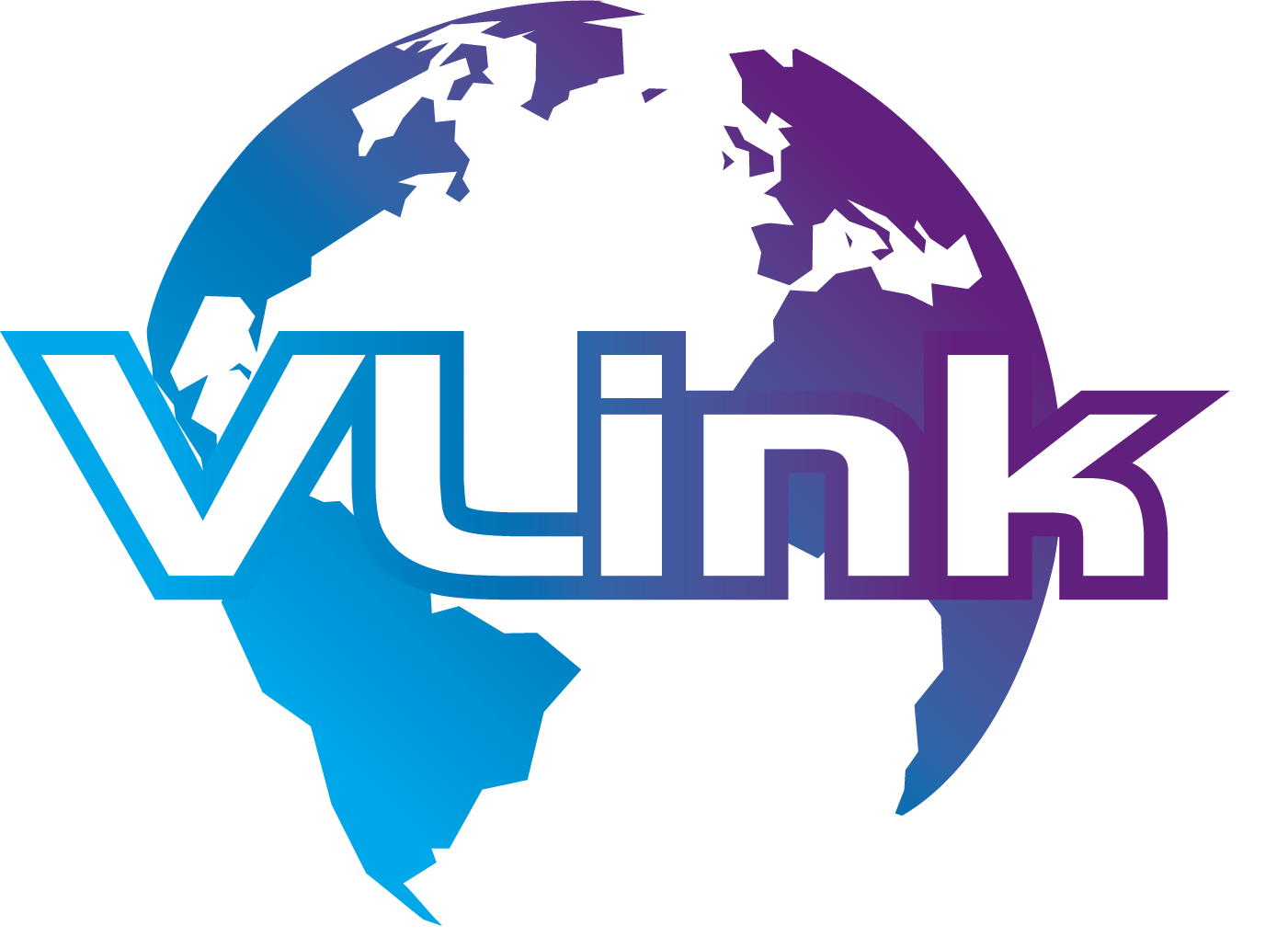









 Shivisha Patel
Shivisha Patel

















